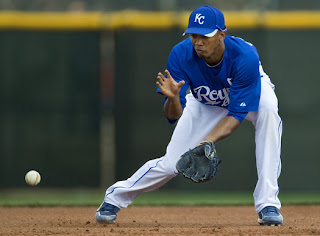You are here:
Home /
BLOG /
Infield / Fielding in "less than ideal" conditions
Fielding in "less than ideal" conditions
Note: For the past two days, Blogger has not been allowing writers to add/edit posts due to maintenance issues with the site. Sorry to those who check in daily. Hopefully Blogger will not let that happen again.
In my area of the country (Pennsylvania), the second week of May is usually when the weather begins to be consistently warmer and drier. Finally baseball weather! Although that is good news for all those in the baseball community, there are two downsides to this. One, the school season is just about over at this point, and Two, field conditions can start to deteriorate pretty fast. I’ll deal with the second point today.
 |
A bare hand above the glove not only helps with
the catch and throw transition, it puts some protection
between the ball and the face. |
Dry, warm weather turns many school fields into parking lots making many routine ground balls an adventure. The rainy month of April has its own challenges with rainouts and indoor practices but one benefit to the rain is that it keeps the infield softer and balls tend to be slower with more true hops. The harder fields of May produce faster ground balls that get to infielders (and through the infield) much more quickly. It also creates erratic bounces that can be very dangerous due to the increased speed. This, of course, is good news for hitters that have had a tough time hitting in the colder, wetter earlier portion of the season. It’s not so fun for the infielders. If you have a field that has water access to spray down hard spots, consider yourself lucky. Most fields just have to rely on rain to do that.
With the increase in speed of ground balls and the unpredictability of bounces, infielders need to be even more diligent in their fundamentals, especially their footwork. Many of these fundamentals were addressed at length in previous infield posts. I would recommend going back to some of them for a refresher. Below are a few pointers that I find help fielders adapt the most to unfavorable field conditions.
Play deeper. Because ground balls will get to you quicker on a hard playing surface, infielders can afford to play a little deeper than normal. Certainly game situations will dictate where to play but in general, playing a step or two deeper is a good strategy this time of year.
 |
Bare hand to the side and nothing protecting
the face on a bad hop. |
Top hand. Not only does this basic fundamental of fielding help with the catch and throw transition, keeping your bare hand on top gives fielders much more peace of mind on ground balls. When a fielder’s brain knows that there is something between the ground ball and their nose, the head is more likely to stay down on the ball (top photo). When a fielder keeps his bare hand down to the side or behind the glove, the brain senses that there is no protection between the ball and the face (bottom photo). That’s when the fielder starts to pick his head up too quickly to get it out of the way of a possible bad hop. A ball between the legs is many times the result.
Get to the right. In my opinion, this is at the top of the list when it comes to basic fielding of ground balls. It also helps fielders on bad hops. Many bad hops will cause a ball to be bobbled in the process of fielding and throwing. If the player has properly positioned himself to the right of the ground ball before fielding, his body will be moving towards first base as he bobbles the ball. If this is the case, he will be able to “carry” the bobble with him towards first base. Because his momentum is heading towards first and the distance of the throw is being shortened along the way, a fielder still will have the ability to bobble a ball, get control of it, and throw a runner out. If the fielder never got to the right of the ball and approached the grounder straight on, their momentum and therefore the bobble, will go towards home plate. If the fielder regains control of the ball, he will still have to change his direction towards first in order to throw. This takes more time and usually involves a longer throw. Put the two together and the runner will most likely be safe.
Stay aggressive. The last thing a fielder wants to do is become tentative on ground balls. It is understandable why it happens though. Nobody wants to take a ball off the nose, especially if they got hit previously. All players can get “gun shy” but it is definitely something each player must fight through. As soon as the player starts thinking more about the bad hops than the play at hand, the performance will start to spiral downward very quickly. It can be very tough to do, especially for young players, but staying aggressive and attacking ground balls is something that must be done regardless of field conditions.







Leave a Reply